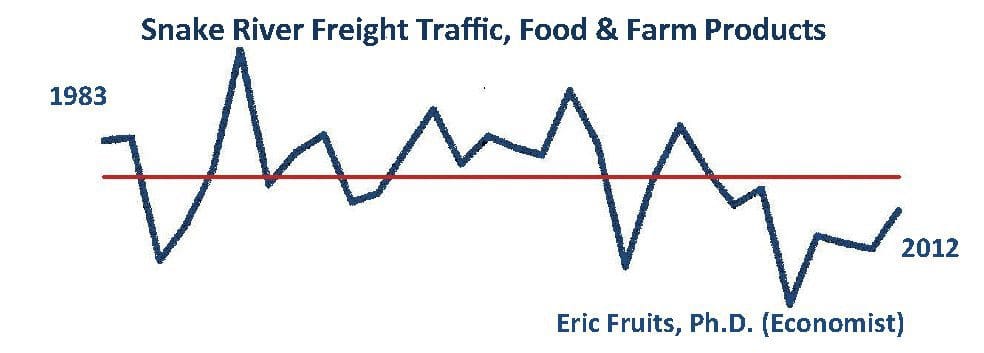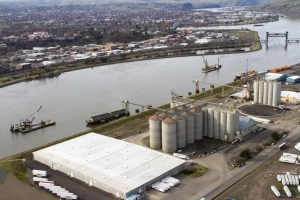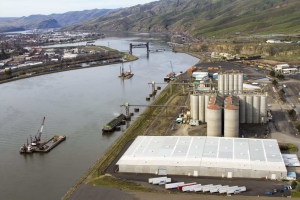Over time, sediment builds up along the Columbia-Snake River System and navigation channel maintenance in the form of dredging is required to ensure safe passage for barges and cruise ships.
The US Army Corps of Engineers is congressionally authorized to maintain a 14’ deep by 250’ wide navigation channel on the Columbia-Snake River System. Sediment management plans follow federal guidelines and are issued from the USACE prior to dredging activity.
Recent dredging of the Snake River Channel took place in 1999, 2006, 2015 and 2023.
In November 2014 the USACE issued two Records of Decision in advance of maintenance dredging for the Lower Snake River. The first was for the long-term Lower Snake River Final Programmatic Sediment Management Plan and the second was for a current “immediate need” action (dredging) to re-establish the congressionally authorized dimensions of the Lower Snake River federal navigation channel.
Areas in need of dredging at the time included the downstream lock approach at Ice Harbor Dam and the confluence of the Snake and Clearwater rivers at the upstream end of the Lower Granite Reservoir, as well as berthing areas at the Ports of Lewiston and Clarkston.
Few rivers are naturally deep and free of sediment build-up, therefore maintenance dredging is a commonplace activity. According to the USACE, more than 400 ports and 25,000 miles of navigation channels are regularly dredged throughout the U.S.
Even though dredging is a regular activity for our country’s marine highways, dredging sometimes meets with legal challenges. This was true of the most recent effort to dredge the Lower Snake River channel.
However, the 2015 legal challenge was quickly dismissed in court. On January 5, 2015, Judge James Robart of the U.S. District Court’s Western District of Washington, ruled in favor of the federal government and denied an injunction to halt dredging on the Snake River. On Feb. 9, 2016, Judge Robart ruled unequivocally in favor of the federal government and dismissed the merits portion of the Snake River Programmatic Sediment Management Plan lawsuit.
In 2015, after nine years without maintenance dredging, the local river channel was returned to a safe depth of 14′. The work was done during the USACE’s annual in-water work window, Dec. 15-Feb. 28. This is when salmonid fish are less likely to be present in the water.
According to the USACE, dredged materials were used to construct additional shallow water fish habitat near Knoxway Canyon, about 23 miles downstream of Clarkston, Washington.
Dreding the Snake and Clearwater Rivers' channels helps enable about 9 million tons of cargo, worth $3 billion, transit the Columbia Snake River System annually, including about 40 percent of the nation's wheat.
USACE INTERCOM MAGAZINE, 2015
A recent drop in totals is due to:
- The Great Recession
- A significant lock outage (2010-11)
- Closure of the Port of Wilma oil storage terminal
- Labor issues at the Port of Portland
Despite it all, the Port of Lewiston’s primary exports—food and farm products— are now near the long-run average.
In 2013, the Port of Lewiston exported approximately 23.5 million bushels of grain and 4,400 containers. The 2013/2014 crop was the largest ever handled by the Lewis-Clark Terminal.
The US Army Corps of Engineers estimates the movements on the Lower Snake River save about $10.90 per ton versus moving by rail. In 2012, 3.3 million tons traveled the Lower Snake River saving local shippers approximately $36 million, money that can circulate in the local economy rather than paying transportation costs.
Dredging Information
- USACE explains maintenance dredging in channels across the country
- Lower snake river programmatic sediment management plan
- USACE notice of channel maintenance completion - February 26, 2015
- Pacific Northwest Waterways Association Press Release regarding Judge Robart's Feb. 2016 Ruling
- Complete February 2016 Court Ruling Regarding Dredging
- USACE 2015 Intercom Magazine Highlights Snake River Dredging
- PNWA press release regarding judge robart's feb. 2016 ruling
- Dr. Eric Fruits - An Economic Analysis of Snake River Barging and The Benefits of Dredging
- Dr. Eric Fruits - Review of Comments Regarding the Economics of Lower Snake River Dredging (2014)
Dredging Images
Dredging By The Numbers

OPPONENTS TO DREDGING CLAIM THAT FREIGHT TRAFFIC IS IN STEADY DECLINE, BUT THE TRUE NUMBERS REFLECT HISTORIC FLUCTUATIONS
9 Years
Since the 14' deep by 250' wide navigation channel and berthing areas at Lewiston and Clarkston have been dredged. As a result, some areas within the navigation channel are as shallow as 7'.
6 Years
Grain barges have been light loaded for 6 years to avoid being grounded. Light loading results in higher shipping costs and affects the ability of grain shippers to compete in export markets.
5 Grain Barges
Five grain barges, although light loaded, have "ground out," or struck underwater sediment since the last navigation channel maintenance. This poses major safety concerns for workers and other users of the navigation channel present at the time of grounding.
Twice the Cost
A local farmer's cost to export would easily double without the option to barge. Assuming an alternative mode would be available, as there is shortage in rail and truck service.
36 Million
The amount the US Army Corps of Engineers estimates shippers save annually by barging instead of using other forms of transportation.
26,000 People
26,000 cruise boat guests and crew members made use of the Port of Clarkston facilities in 2014. Currently, some cruise boats cannot use the dock specifically designed for tourism and must instead off-load at an industrial dock. This discourage cruise boats from staying in our area and limits money spend in the valley. Failure to maintain the navigation channel and berthing areas impacts more than agriculture and industry - it hurts tourism and recreational users as well.
Less Polution
Barging creates 33% less air pollution than diesel trains and 373% less air pollution than trucks. The environmental benefits of barging freight compared to other transportation options should be included when weighing the benefits of maintaining the navigation channel.











